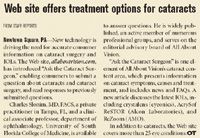Article
Three-step technique allows controllable capsule staining
Cincinnati—A three-step technique for stain- ing the anterior lens capsule using trypan blue ophthalmic solution (Vision Blue, Dutch Ophthalmic Research Center International), balanced salt solution (BSS), and sodium hyaluronate 2.3% (Healon5, Advanced Medical Optics) affords an easy, safe, and precise method to facilitate capsulorhexis in cataract surgery cases where capsule visualization is difficult, said Robert H. Osher, MD.

In the first step of the procedure, the anterior chamber is filled with Healon5. Next, using a 27-gauge cannula, BSS is placed directly onto the anterior capsule, lifting the Healon5 into the corneal dome and creating a wafer-thin, fluid monolayer lying behind the ophthalmic viscosurgical device (OVD). Finally, the trypan blue is slowly introduced onto the lens surface using a tuberculin syringe attached to a 27-gauge cannula (MMP203, Duckworth & Kent) specially designed for this procedure. The cannula features a curved shaft that mimics the convexity of the anterior lens capsule and has a single opening on its posterior surface to facilitate deposition of the dye directly onto the face of the capsule.

A number of other methods using various dyes have been described for staining the anterior lens capsule to improve visualization of the torn capsule edges while making the capsulorhexis in eyes with a white or brunescent cataract. Dr. Osher credited Dutch ophthalmologist Gerritt Melles, MD, with first reporting the use of trypan blue. However, Dr. Melles' technique involved aspirating aqueous humor, using air to re-form the anterior chamber, and then injecting the dye onto the anterior capsule beneath the air bubble.
"Air injection carries a liability because air is not as effective in maintaining chamber stability, and it can be more toxic to the corneal endothelium. The safety of the three-step technique is demonstrated by our observation of clear corneas at follow-up on the first postoperative day," Dr. Osher said.
Other surgeons have described a two-step technique in which the dye is introduced into an OVD-filled anterior chamber. However, with that approach, the surgeon has poor control over dye dispersion because it tends to form "ink blots" in the OVD that block visualization of the anterior capsule. In addition, if the quantity of the dye or injection pressure is too great, the dye can be forced peripherally to cause staining of the iris or posteriorly into the vitreous through the zonules.
Dr. Osher noted the three-step technique can also be performed using indocyanine green.
Dr. Osher began using the three-step technique in 1999 and published it last year [Marques DMV, et al. J Cataract Refract Surg 2004;30:13-16].
Newsletter
Don’t miss out—get Ophthalmology Times updates on the latest clinical advancements and expert interviews, straight to your inbox.




